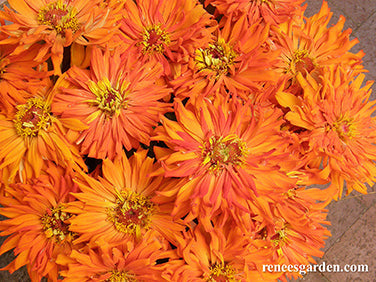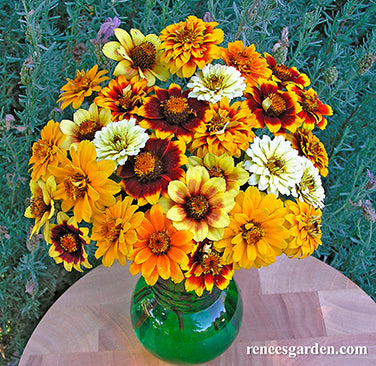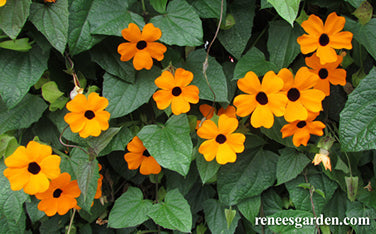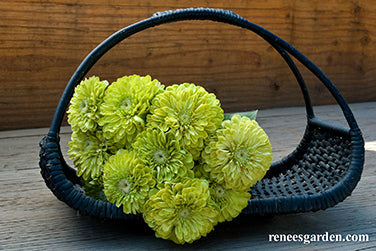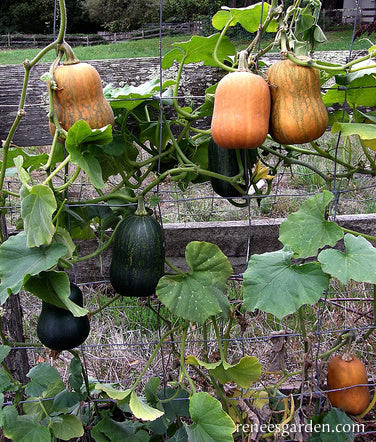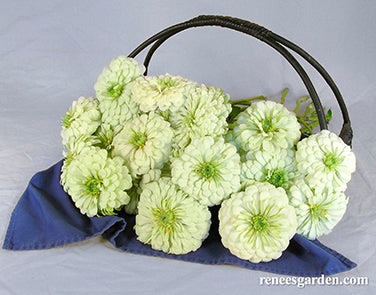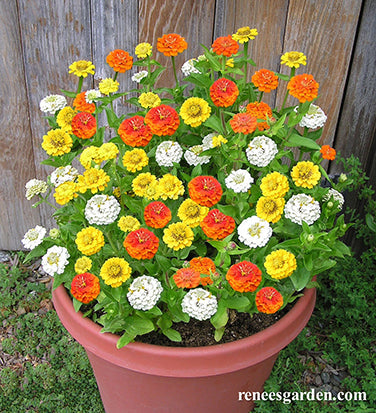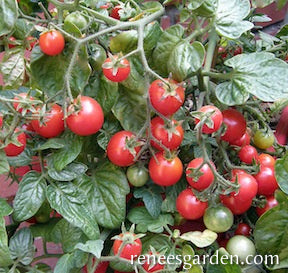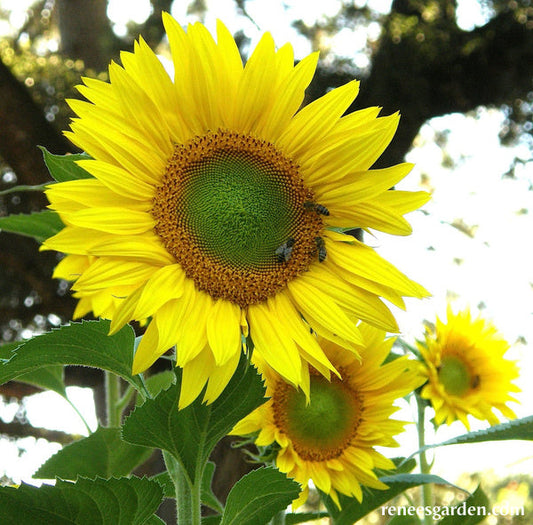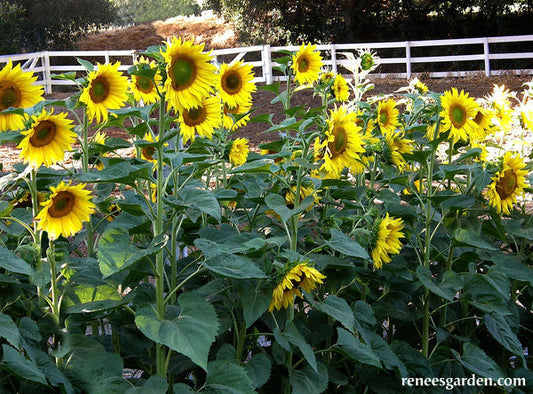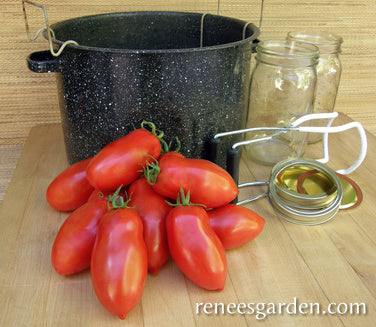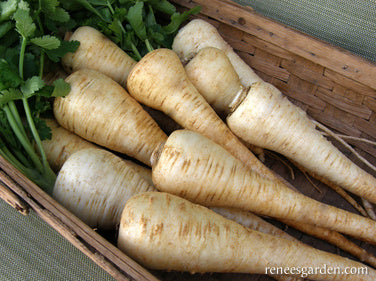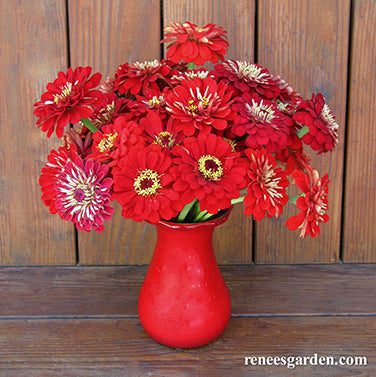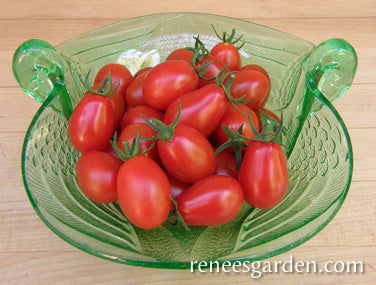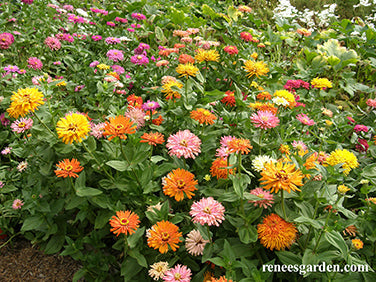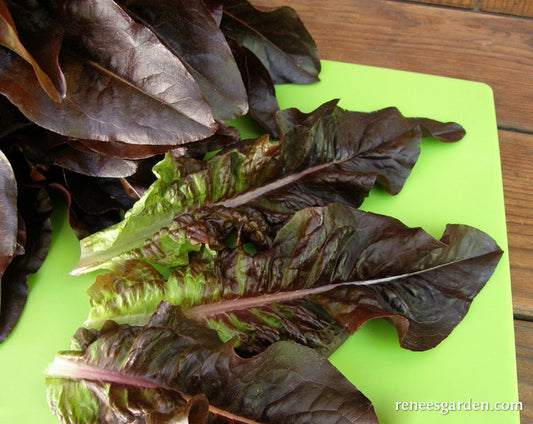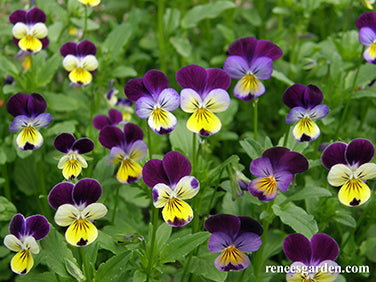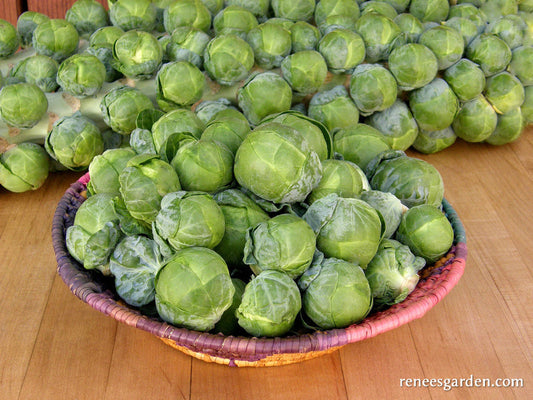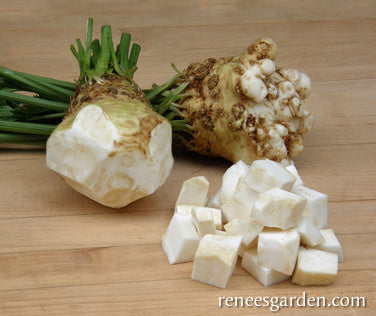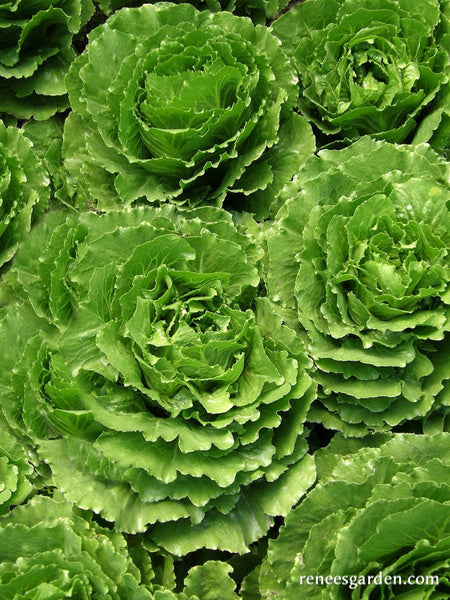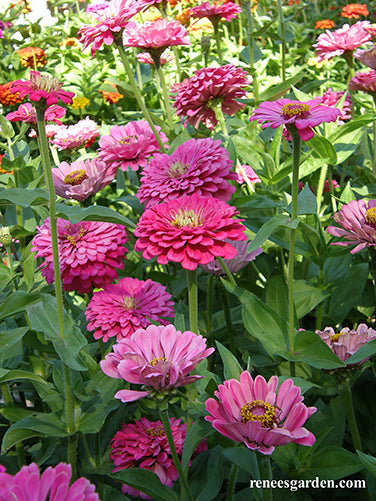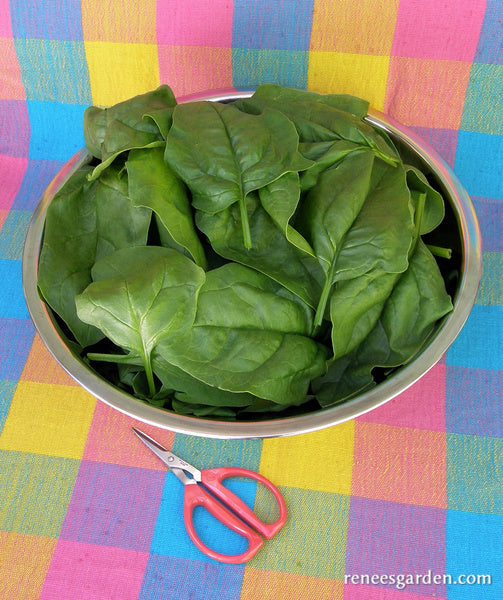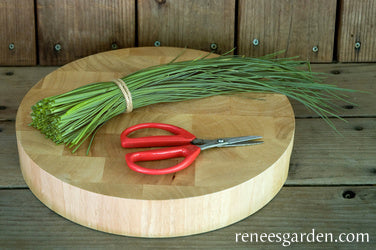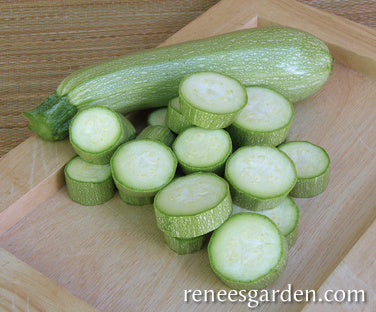All
-
Butterfly Zinnias Mighty Lion
ANNUAL
Summer/fall bloom
Frost tenderTO START DIRECTLY IN THE GARDEN
Sow seeds in well-worked soil in full sun when danger of frost is past and weather is warm and above 50°F (10°C) both day and night. Space seeds 2 to 3 inches apart in rows 12 inches apart, cover about 1/2 inch deep and gently firm soil. Keep soil evenly moist while awaiting germination.
TO START EARLY INDOORS
Four weeks before last frost date, sow seeds 1/2 inch deep and 3 inches apart in a container of seed starting mix. Keep warm and moist and provide a strong light source until seedlings are ready to plant outside when temperatures rise above 50°F (10°C) day and night.
THIN OR TRANSPLANT
Space seedlings 8 to 12 inches apart when large enough to handle to give plants room to mature and provide good air circulation.
GROWING NOTES
Zinnias prefer well amended soil in full sun. For large and abundant flowers, thin before seedlings get crowded; adequate spacing and regular, even watering helps keep zinnias productive and discourages mildew. Pick when flower blossoms first open and petals are tight for longest vase life. Cut long stems well back into the plant to keep plants branching low and producing best blooms for summer long bouquets.Regular price $2.99Sale price $2.99Unit price / per -
Heirloom Butterfly Zinnias Persian Carpet
ANNUAL
Summer/fall bloom
Frost tenderTO START DIRECTLY IN THE GARDEN
Sow seeds in well-worked soil in full sun when danger of frost is past and temperatures are above 50°F (10°C) both day and night. Space seeds 2 to 3 inches apart in rows 12 inches apart, cover about 1/2 inch deep and gently firm soil. Keep evenly moist while awaiting germination.
TO START EARLY INDOORS
Four weeks before last frost date, sow seeds 1/2 inch deep and 3 inches apart in containers of seed starting mix. Keep warm and moist and provide a strong light source. Feed with 1/2 strength fertilizer every 2 weeks. Just as soon as seedlings have several sets of true leaves, plant outdoors when temperatures stay above 50°F (10°C) at night.
THIN OR TRANSPLANT
Space seedlings 8 to 10 inches apart when large enough to handle to provide good air circulation and give plants room to mature.
GROWING NOTES
Zinnias grow readily in ordinary garden soil in full sun. Be sure to thin before seedlings get crowded; adequate spacing and regular even watering help keep zinnias productive and disease free. Grow colorful Persian Carpet in beds or borders, or combine with white alyssum, dwarf marigolds, petunias and salvia for season-long bloom in terracotta pots and color bowls.Regular price $2.99Sale price $2.99Unit price / per -
Old-Fashioned Thunbergia Black-Eyed Susan Vine
ANNUAL VINE
Summer/fall bloom
Frost tenderTO START OUTDOORS
In late spring, once weather is warm and settled and nights stay consistently above 50°F (10°C ), plant seeds in a sunny, sheltered spot in well-drained, fertile garden soil 6 inches apart and ½ inch deep. Provide supports at planting time. Keep soil moist but not soggy while awaiting germination, which can be somewhat slow and erratic.
TO START EARLY INDOORS
Sow indoors 5 to 6 weeks before last expected frost in individual pots of seed starting mix. Cover ½ inch deep and keep warm and moist. Provide a strong light source until seedlings are ready for outdoor planting. Once nights stay consistently above 50°F (10°C), transplant outdoors, 6 inches apart, being careful not to disturb delicate roots.
GROWING NOTES
These plants grow best in a sheltered spot, out of the wind. Thunbergia germinates and grows slowly at first, then begins to twine and develop flowers at midsummer. It is a charming choice for hanging baskets, where the vines will grow up and form a pyramid of bloom (plant four seedlings in a 10 to 12 inch diameter basket and feed regularly). Or, grow the vines up a trellis or arbor for a lovely effect.Regular price $3.99Sale price $3.99Unit price / per -
Heirloom Zinnias Green Envy
ANNUAL
Summer/fall bloom
Frost tenderEASY TO START DIRECTLY IN THE GARDEN
Sow seeds in well-worked soil in full sun when danger of frost is past and weather is warm and above 50°F (10°C) both day and night. Space seeds 2 to 3 inches apart in rows 12 inches apart, cover about 1/2 inch deep and gently firm soil. Keep soil evenly moist while awaiting germination.
TO START EARLY INDOORS
Four weeks before last frost date, sow seeds ½ inch deep and 3 inches apart in a container of seed starting mix. Keep warm and moist and provide a strong light source until seedlings are ready to plant outside when temperatures rise above 50°F (10°C) day and night.
THIN OR TRANSPLANT
Space seedlings 8 to12 inches apart when large enough to handle so plants have good air circulation and enough elbow room to grow and bloom freely.
GROWING NOTES
Zinnias can grow in ordinary garden soil in full sun. For large, abundant flowers, thin before seedlings get crowded. Adequate spacing and regular, even watering discourages mildew and keeps zinnias productive.
Pick just as blossoms begin opening and petals are tight. Cut long stems well back into the plant to keep plants branching low and producing best blooms for summer long bouquets.
Regular price $2.99Sale price $2.99Unit price / per -
Baby Butternut Squash Climbing Honey Nut
BEST TO START OUTDOORS
Honey Nuts need full sun, rich fertile soil and warm temperatures. Wait to plant until nights are comfortably above 50°F (10°C) both day and night. Sow groups of 2 to 3 seeds 2 ft. apart and 1 in. deep in rows 4 ft. apart. Thin to 1 strong seedling per group to give vines room to ramble or climb. Or make slightly mounded hills 2 to 3 ft. across and 6 ft. apart and plant 4 to 5 seeds in each hill. When seedlings have several sets of leaves, thin to the strongest 3 seedlings per hill.
GROWING NOTES
Protect young seedlings from marauding birds by covering with plastic berry baskets at sowing time, removing before plants get crowded. To save space, and make picking easy, Honey Nut vines can easily be trained up fences, trellises or 4-6 foot tall teepees.
HARVEST AND USE
These delicious little squashes need to mature properly, so don’t harvest until vines have died back and squashes’ exterior rinds are fully colored up from dark green to orangey-tan and tough enough to resist piercing with a fingernail. Then cut squashes from vines, leaving a good stem handle. Let squashes cure in the sun for about 10 days, then store in a cool dry place and they’ll keep for months. In the kitchen, cut Honey Nuts in half then bake until tender. Flesh is meltingly sweet and delicious.Regular price $4.89Sale price $4.89Unit price / per -
Heirloom Butterfly Zinnias Polar Bear
ANNUAL
Summer/fall bloom
Frost tenderTO START DIRECTLY IN THE GARDEN
Sow seeds in well-worked soil in full sun when danger of frost is past and weather is warm and above 50°F (10°C) both day and night. Space seeds 2 to 3 inches apart in rows 12 inches apart, cover about 1/2 inch deep and gently firm soil. Keep soil evenly moist while awaiting germination.
TO START EARLY INDOORS
Four weeks before last frost date, sow seeds 1/2 inch deep and 3 inches apart in a container of seed starting mix. Keep warm and moist and provide a strong light source until seedlings are ready to plant outside when temperatures rise above 50°F (10°C) day and night.
THIN OR TRANSPLANT
Space seedlings 8 to 12 inches apart when large enough to handle so plants have good air circulation and enough elbow room to grow and bloom freely.
GROWING NOTES
Zinnias can grow in ordinary garden soil in full sun. For large, abundant flowers, thin before seedlings get crowded. Adequate spacing and regular, even watering discourages mildew and keeps zinnias productive.
Pick just as blossoms begin opening and petals are tight. Cut long stems well back into the plant to keep plants branching low and producing best blooms for summer long bouquets.
Regular price $2.99Sale price $2.99Unit price / per -
Container Zinnias Pixie Sunshine
ANNUAL
Summer/fall bloom
Frost tenderEASIEST TO PLANT OUTDOORS
After danger of frost is past, sow seeds in full sun in well-worked soil. For container sowing, use fresh potting mix. Space seeds 2-3 inches apart, cover about 1/2 inch deep and gently firm soil. Keep soil evenly moist while awaiting germination. When seedlings are several inches tall, thin to final spacing: For Containers, 5 to 6 plants per 12 inch pot; In Garden Beds, space 8 inches apart.
TO START EARLY INDOORS
Several weeks before last frost date, sow seeds 1/2 inch deep and 2 inches apart in a container of seed starting mix. Keep warm and moist and provide a strong light source until ready to plant outdoors. Transplant carefully before plants get too large. Space plants carefully, so roots have room to grow and spread.
GROWING NOTES
For container planting, use pots at least 12 inches in diameter and 12 inches deep. These carefree 8 to 12 inch tall zinnias perform well in hot and sunny conditions. Water regularly and consistently. Support plants’ rapid growth by feeding with a well-balanced fertilizer every few weeks. Thin young seedlings to final spacing before too large. Remove spent flowers often to encourage new blooms.
Regular price $3.39Sale price $3.39Unit price / per -
Windowbox Tomatoes Litt'l Bites Cherry
STARTING SEEDLINGS
In early spring, start indoors about 6 weeks before night temperatures are reliably in the 50-55°F (10-13°C). Sow seeds 1/4 in. deep and 1 in. apart in a container of seed starting mix. Keep moist but not soggy, and very warm, 80°F (27°C). Provide a strong light source until seedlings are ready to plant outside. When seedlings are 2 in. tall, transplant into individual 4-in. pots. Maintain at 70°F (21°C). Feed with half-strength fertilizer every 2 weeks until ready to plant. When night temperatures are reliably in the 55°F (13°C) range, gradually acclimate to outdoor conditions.
Container Growing: Transplant one seedling per pot or basket that is at least 16 in. in diameter and 16 in. high. Container tomatoes need a location with at least 6 hours of sun per day. Use fresh potting mix to prevent soil borne disease. Mulch plants well and water regularly: in hot weather, pots may need water daily. Fertilize every other week with a low nitrogen fertilizer for strong plants and good yields.
HARVEST AND USE
Litt’l Bites plants cascade attractively from their containers and are soon covered with tasty little cherry tomatoes. Pick and enjoy these cute little baby tomatoes frequently when red ripe to encourage the most production. For best flavor don’t store Litt’l Bites in the fridge.Regular price $4.99Sale price $4.99Unit price / per -
Songbird/Pollinator Flowers The Birds & Bees Sunflowers
ANNUAL
Spring/summer/fall bloom
Frost tenderEASY TO START OUTDOORS
Plant in full sun in good garden soil when all danger of frost is past and temperatures have reached at least 50°F (10°C) both day and night. Poke seeds into well-worked soil 1 inch deep and 6 inches apart. Press soil firmly over seeds and keep moist as seedlings emerge.
Thin or Transplant: When seedlings are about 3 inches tall, thin them to 12 inches apart with 2 feet between rows, to give growing plants room to establish strong roots and sturdy stalks that won’t blow over.
GROWING NOTES
Keep soil moist and well weeded and protect seedlings from birds at planting time with netting or plastic berry baskets, removing before plants get crowded. For large heads, space seedlings properly 12 inches apart so plants can grow to full size.
HARVEST AND USE
As flowers bloom, bees pollinate the florets in each head and the seeds begin to mature. When the center disk florets have dried up, birds of all sorts will visit to snack on the ripening seed heads.
To harvest for feeding birds in fall and winter: cover heads with paper bags till ripened kernels are plump and hard-shelled, then cut entire heads, let them fully dry. Remove the seeds by hand into a basket, then blow off loose chaff. Store in closed containers to feed as needed.
Regular price $3.39Sale price $3.39Unit price / per -
Snack Seed Sunflowers Heirloom Mammoth Greystripe
ANNUAL
Summer/fall bloom
Frost tenderEASIEST TO START DIRECTLY IN THE GARDEN
Plant in full sun in good garden soil when all danger of frost is past and temperatures have reached at least 50°F (10°C) both day and night. Poke seeds into well-worked soil 1 inch deep and 6 inches apart. Press soil firmly over seeds and keep moist as seedlings emerge.
THIN OR TRANSPLANT
When seedlings are about 3 inches tall, thin to 12 to 18 inches apart with 2 feet between rows to give growing plants room to establish strong roots and sturdy stalks that won’t blow over.
GROWING NOTES
Keep soil moist and well weeded and protect seedlings from birds at planting time with netting or plastic berry baskets, removing before plants get crowded. For large heads, space seedlings at least 12 inches apart so plants can grow to full size.
HARVEST AND USE
As sunflowers bloom, bees pollinate the florets in each head and seeds begin to mature. When center disk florets have dried up, cover the ripening seed heads loosely with paper bags if you don’t want birds to eat the seeds. When ripened kernels are plump and hard-shelled, cut entire heads, dry fully, then remove the seeds by hand. Store in closed containers to eat for snacks or feed to the birds over the winter.Regular price $4.89Sale price $4.89Unit price / per -
Heirloom Sauce Tomato Italian San Marzano
STARTING SEEDLINGS
In early spring, start indoors about 6 to 8 weeks before outdoor night temperatures are reliably in the 50-55°F (10-13°C) range. Sow seeds 1/4 inch deep and 1 inch apart in a container of seed starting mix. Keep moist but not soggy, and very warm, 80°F (27°C). Provide a strong light source until seedlings are ready to plant outside.
When 2 inches tall, transplant into individual 4-inch pots, burying stems up to base of leaves. Maintain at 70-75°F (21-24°C). Feed with half-strength fertilizer every 2 weeks until ready to plant, then gradually acclimate seedlings to outdoor conditions. When nights reach 55°F (10°C), transplant 3 feet apart into rich soil in full sun.
GROWING NOTES
Prepare soil well with aged manure or compost. Plant several inches deeper than seedlings were growing in containers. Provide strong stakes or tall wire cages at planting time. Mulch to provide even moisture retention; don’t overwater once fruit begins to ripen.
HARVEST AND USE
These plump, sausage-shaped tomatoes are good fresh eating as well as traditional and perfect for making thick rich sauce. Big harvests of whole ripe fruits can be frozen in ziplock bags to make sauce later at your leisure.Regular price $4.89Sale price $4.89Unit price / per -
English Parsnips Savour
START SEEDS DIRECTLY OUTDOORS
After all danger of frost is over in spring, sow seeds in well-worked, very fertile soil in full sun. Space seeds 1 inch apart and cover 1/2 inches deep. Make rows 10 inches apart. Be patient; parsnips germinate slowly and unevenly. Tip: Drop a radish seed every 6 inches or so to mark the row and help break the soil crust. Parsnips will easily fill in once radishes are harvested.
GROWING NOTES
When large enough to handle, carefully thin seedlings to stand 3 to 4 inches apart so these big deep roots will have room to size up. Keep growing parsnips consistently moist and well weeded. Feed several times during active growth as parsnips grow best in very fertile soil.
HARVEST AND USE
Wait to harvest until late fall cold weather; flavor is sweetest & best after several hard frosts. As you need them, dig out roots carefully with a shovel or spading fork. In cold winter climates, protect parsnips from freezing with a thick mulch. Parsnips are delicious peeled, cut in chunks, tossed with olive oil & roasted until tender by themselves or with other root vegetables. Or slice them up to sauté gently in butter or steam and mash.
Regular price $3.39Sale price $3.39Unit price / per -
Heirloom Cutting Zinnias Moulin Rouge
ANNUAL
Summer/fall bloom
Frost tenderEASY TO START DIRECTLY IN THE GARDEN
Sow seeds in well-worked soil in full sun when danger of frost is past and weather is warm and above 50°F (10°C) both day and night. Space seeds 2 to 3 inches apart in rows 12 inches apart, cover about 1/2 inch deep and gently firm soil. Keep soil evenly moist while awaiting germination.
TO START EARLY INDOORS
Four weeks before last frost date, sow seeds 1/2 inch deep and 3 inches apart in a container of seed starting mix. Keep warm and moist and provide a strong light source until seedlings are ready to plant outside when temperatures rise above 50°F (10°C) day and night.
THIN OR TRANSPLANT
Space seedlings 8 to12 inches apart when large enough to handle so plants have good air circulation and enough elbow room to grow and bloom freely.
GROWING NOTES
Zinnias grow readily in ordinary garden soil in full sun. For large and abundant flowers, thin before seedlings get crowded; adequate spacing and regular, even watering help keep zinnias productive and discourages mildew. Pick when flower blossoms first open and petals are tight for longest vase life. Cut long stems well back into the plant to keep plants branching low and producing best blooms for summer long bouquets.Regular price $3.39Sale price $3.39Unit price / per -
Italian Grape Tomato Pandorino
STARTING SEEDLINGS
In early spring, start indoors about 6 to 8 weeks before outdoor night temperatures are reliably in the 55°F (13°C). Sow seeds 1/4 inch deep and 1 inch apart in a container of seed starting mix. Keep moist but not soggy, and very warm, 80°F (27°C). Provide a strong light source until seedlings are ready to plant outside. When 2 in. tall, transplant into individual 4-inch pots, burying stems up to base of leaves. Maintain at 70°F (21°C). Feed with half-strength fertilizer every 2 weeks until ready to plant, then gradually acclimate seedlings to outdoor conditions. When nights reach 55°F (13°C), transplant 3 feet apart into rich soil in full sun.
GROWING NOTES
Prepare soil well with aged manure or compost. Plant several inches deeper than seedlings were growing in containers. Provide firmly anchored strong stakes or tall wire cages at planting time. Mulch to provide even moisture retention; do not over water once fruit begins to ripen. Harvest and Use Plants will grow tall and heavy with fruit clusters. For best full, sweet flavor, pick only when fully ripened to rich red. Don’t store in the refrigerator. Delicious Pandorino grape tomatoes are sweet and irresistible straight out of the garden, or sauté them with a little garlic in good olive oil just until they burst, then sprinkle with fresh herbs.Regular price $3.69Sale price $3.69Unit price / per -
Cactus Zinnias Heirloom Raggedy Anne
ANNUAL
Summer/fall bloom
Frost tenderTO START DIRECTLY IN THE GARDEN
Sow seeds in a well-worked seedbed in full sun when danger of frost is past and weather is warm and settled. Space seeds 2 to 3 inches apart in rows 12 inches apart, cover about 1/2 inch deep and gently firm soil. Keep soil evenly moist while awaiting germination.
TO START EARLY INDOORS
One month before last frost date, sow seeds 1/2 inch deep and 3 inches apart in a container of seed starting mix. Keep moist and provide a strong light source until seedlings are ready to plant out. Gradually acclimate to outdoor conditions before transplanting.
THIN OR TRANSPLANT
Space seedlings 10 to 12 inches apart to give plants room to mature.
GROWING NOTES
Zinnias grow effortlessly in ordinary garden soil in full sun. For large and abundant flowers, thin before seedlings get crowded; adequate spacing and regular even watering will ensure free flowering and discourage mildew. Pick flowers often by cutting long stems well back into the plant to keep them branching from below and producing best blooms for bright summer-long bouquets.Regular price $2.99Sale price $2.99Unit price / per -
Heirloom Cutting Lettuce Red Deer Tongue
START SEEDS OUTDOORS
In cool early spring weather, sow seeds in finely worked soil in full sun. Sow seeds about 1 inch apart over the entire seedbed or in wide rows, then cover lightly and evenly with 1/4 inch of fine soil. Firm soil gently and water with a fine spray. Keep seedbed evenly moist. Plant again as weather cools in late summer for fall salads.
GROWING NOTES
Thin seedlings to stand about 6 inches apart so they have room to grow and mature. Heirloom Red Deer Tongue grows and tastes best grown in mild spring or cooler fall weather with consistent moisture. To extend the sowing season slightly, sow in light shade or erect a canopy of loosely woven shade cloth over the bed. Birds are often attracted to tender young seedlings, so protect them with netting if necessary.
HARVEST AND USE
To harvest, wait until the plants form open, loose heads with leaves about 6 inches tall. Use scissors to cut leaves about 1 to 2 inches above the soil level. Water well and fertilize lightly and if weather is still cool, plants will re-grow tasty leaves for another cutting. These tasty, deep red leaves show off in the salad bowl and add interest to any sandwich. Hot summer temperatures turn this heirloom lettuce bitter; plant and harvest in cooler weather.
Regular price $3.39Sale price $3.39Unit price / per -
Heirloom Edible Flowers Grandma's Johnny Jump Ups
PERENNIAL GROWN AS ANNUAL
Spring bloom
Can handle frostBEST TO PLANT DIRECTLY IN THE GARDEN
In Mild Winter Climates, sow seeds in fall and they will form deep roots over winter for a long spring bloom.
In Cold Winter Areas, sow in spring as soon as soil can be worked.
Violas can handle light frosts and bloom best when they get a good start in cool spring weather. Sow seeds 1 inch apart in well-drained soil in full sun. Cover 1/4 inch deep, firm soil and keep seed bed moist. Be patient; germination takes 14 to 21 days. When large enough to handle, thin or transplant seedlings to 4 to 5 inches apart.
To Start Early Indoors: Sow seeds 1 inch apart in seed starting mix, 8 to 10 weeks before last frost. Cover 1/4 inch deep, keep moist & provide a good light source until ready to plant outside when weather warms up. Transplant 4 to 5 inches apart when large enough to handle.
GROWING NOTES
These carefree plants are covered with cheerful flowers throughout spring & early summer. After initial flowering, cut plants back to several inches tall for another flush of bloom if the weather is not too hot. In milder climates, Johnny Jump Ups will self sow readily & come back each season. The dainty edible blossoms taste of wintergreen. They make great garnishes & are also perfect for candying.Regular price $3.39Sale price $3.39Unit price / per -
Brussels Sprouts Hestia
TO START EARLY INDOORS
Start seeds 4 or 5 weeks before last expected spring frost and again in midsummer for a fall crop in mild winter areas. Sow seeds 1 inch apart in a container of seed starting mix, cover lightly, about 1/4 inch deep and keep evenly moist. Provide a strong light source. When seedlings are large enough to handle, gradually acclimate to outdoor conditions, then transplant 24 inches apart into very fertile, well-drained soil in full sun.
TO START OUTDOORS
In early summer, plant seeds in well-worked, fertile soil in full sun. Plant groups of 2 seeds 1/4 inch deep and two feet apart. Space rows 18 inches apart. Thin to 1 strong seedling per group so plants have room to mature and grow.
GROWING NOTES
Brussels sprouts thrive in rich soil amended with lots of organic matter. Keep growing plants well watered and weeded. Feed at least monthly with all-purpose fertilizer. Use nontoxic B.T. (Bacillus thuringiensis) products to repel caterpillar pests as necessary and wash away aphids if they appear.
HARVEST AND USE
Mulch plants well and begin harvesting when sprouts are well filled out, but still tightly closed. Pick lowest sprouts on the elongated stem first, so higher sprouts will continue to grow. Mature Brussels sprouts will handle light frosts and cold weather actually sweetens their flavor.
Regular price $4.99Sale price $4.99Unit price / per -
Celeriac/Celery Root Prinz
TO PLANT OUTDOORS
In spring, when frost danger is over and nights are at least 50°F (10°C), sow seeds in well-worked, fertile soil in full sun. Space seeds 1 to 2 inch apart and cover 1/4 inch deep in rows 12 inch apart. Be patient; celeriac germinates slowly and unevenly. Use row covers to help retain soil moisture; remove after germination. Thin well-established seedlings to 10 inches apart.
TO START EARLY INDOORS
About 6 to 8 weeks before last frost, sow seeds 1 inch apart in a container of seed starting mix. Cover 1/4 inch deep and provide a strong light source. Keep moist but not soggy, and feed seedlings frequently. When several inches tall, transplant 10 inches apart into well-amended garden soil after danger of frost is over.
GROWING NOTES
Celeriac needs rich soil to grow into large harvestable roots. Mulch plants well and feed monthly throughout the growing season.
HARVEST AND USE
Harvest when roots have sized up at least 3 to 4 inches in diameter. Flavor is sweetest in cool fall weather. Harvest as needed; celeriac “stores” well in the ground. Protect from freezing with a thick mulch. Clean, peel and cut up to add wonderful sweet celery flavor to soups, stews or braises, or toss with olive oil and roast until tender. Also delicious freshly grated and dressed with a lemony dressing. Dry celeriac foliage to use for celery flavored seasoning.
Regular price $3.69Sale price $3.69Unit price / per -
Crisphead Lettuce Queen of Crunch
START SEEDS OUTDOORS
In cool early spring weather, start seeds in finely worked soil in full sun. Sow 1/4 inch deep and 2 inches apart in rows 6 to 8 inches apart and cover seeds lightly. Tend carefully and keep evenly moist. Gradually thin out extra seedlings, leaving remaining plants standing 12 inches apart so lettuces have room to size up and fully mature into tight, crunchy rosettes. For a constant supply, make several sowings a few weeks apart until summer weather turns hot. Plant again in late summer for fall harvest.
GROWING NOTES
Lettuce thrives in cool conditions with consistent moisture. Weed, water and thin carefully to proper spacing for best quality heavy heads. If birds are attracted to the young seedlings, cover planting beds with floating row covers or netting. Make a shade structure in hotter climates to extend the growing season.
HARVEST AND USE
Savor young thinnings in your first spring salads. Be sure to thin properly and keep evenly moist for sweet tasting leaves. Harvest by cutting mature heads when they are well filled out. Pull and discard or compost over-mature plants if they begin to elongate (“bolt”) in hot weather as leaves turn bitter at this stage.
Regular price $4.39Sale price $4.39Unit price / per -
Cutting Zinnias Raspberry Sorbet
ANNUAL
Summer/Fall bloom
Frost tenderTO START DIRECTLY INTHE GARDEN
Sow seeds in well-worked soil in full sun when danger of frost is past and weather is warm and above 50°F (10°C) both day and night. Space seeds 2 to 3 inches apart in rows 12 inches apart, cover about 1/2 inch deep and gently firm soil. Keep soil evenly moist while awaiting germination.
TO START EARLY INDOORS
Four weeks before last frost date, sow seeds 1/2 inch deep and 3 inches apart in a container of seed starting mix. Keep warm and moist and provide a strong light source until seedlings are ready to plant outside only when temperatures rise above 50°F (10°C) both day and night.
THIN OR TRANSPLANT
Space seedlings 8 to 12 inches apart when large enough to handle, giving these large framed plants room to mature and providing good air circulation.
GROWING NOTES
Zinnias grow readily in ordinary garden soil in full sun. For abundant and healthy flowers, thin before seedlings get crowded; adequate spacing and regular, consistent watering helps keep zinnias un-stressed and productive and discourages mildew. For long-lived bouquets, cut flowers in the morning when blossoms first open and petals are tight. Cut long stems well back into the plant to keep plants branching low and producing abundant blooms to attract butterflies and other pollinators.Regular price $3.39Sale price $3.39Unit price / per -
Longstanding Spinach Gangbusters
START SEEDS OUTDOORS
In early spring when danger of hard frost is over, sow seeds in well-worked fertile soil in full sun. Sow seeds 1 inch apart and 1/2 inch deep in rows 10 inches apart, or broadcast thinly for bed planting. Be sure to firm soil well over seeds to ensure good germination. If first sowing germinates unevenly, plant more seeds as they will catch up fast.
GROWING NOTES
Spinach is most productive grown in cool spring conditions and sown again in late summer for a fall crop. After seedlings reach 2 to 3 inches tall, thin out every other plant (and enjoy in early salads) and keep thinning in this fashion until plants are spaced 5 or 6 inches apart. Keep the shallow-rooted plants well weeded and watered. Spinach is a heavy feeder so fertilize several times with fish emulsion solution for best harvests.
HARVEST AND USE
There are two methods for harvesting spinach: either cut the entire plant 1 inch or so above the base once plants are 4 or 5 inches tall, or wait until plants are well established and harvest just the outer leaves, leaving at least 4 center leaves so plant will continue to grow. Water and fertilize after cutting and plants will provide 2 or 3 pickings before weather gets too warm and spinach begins to go to seed.Regular price $4.89Sale price $4.89Unit price / per -
Heirloom Culinary Chives
PERENNIAL
Spring/summer/fall harvest
Frost hardyTO PLANT OUTDOORS
In cool spring weather, sow clusters of 7 to 10 seeds about 8 to 10 inches apart in well-worked, fertile soil in sun or part shade. Cover 1/4 inch deep and press soil firmly over seeds. Keep evenly moist as seeds germinate slowly over several weeks. Emerging clusters of seedlings have very slender grass-like leaves that mature into mounds.
TO START EARLY INDOORS
In early spring, sow 7 to 10 seeds in individual containers of starting mix and cover 1/4 inch deep. Keep evenly moist as seedlings slowly emerge and provide a good light source until ready to plant outdoors. Transplant clusters of seedlings when 2 to 3 inches tall after gradually acclimating plants to outdoor conditions.
THIN OR TRANSPLANT
Space clusters of 7 to 10 seedlings 8 to 10 inches apart.
GROWING NOTES
Chives bear lilac-pink clover-like flowers in late spring and summer. After bloom finishes, cut entire plant back to 2 inches to encourage regrowth of tender new leaves. Given plenty of moisture and a location out of fierce sun, chives are hardy, self-sufficient plants. lilac-pink clover-like flowers in late spring and summer. After bloom finishes, cut entire plant back to 2 inches to encourage regrowth of tender new leaves. Given plenty of moisture and a location out of fierce sun, chives are hardy, self sufficient plants.Regular price $4.89Sale price $4.89Unit price / per -
Middle Eastern Zucchini Clarimore
START SEEDS OUTDOORS
All zucchinis need full sun, rich fertile soil and warm temperatures. Plant only when spring weather is warm and night temperatures stay above 50°F (10°C). Sow 2 to 3 seeds, 1 inch deep, every 2 feet, in rows 3 feet apart. Thin to leave only 1 seedling every 2 feet. Or, plant in slightly mounded hills, 2 feet in diameter, sowing 5 or 6 seeds in each hill. Thin hill planted seedlings to 2 or 3 strongest plants.
GROWING NOTES
Amend soil well before sowing with lots of aged manure or compost. Protect young seedlings from marauding birds by covering with plastic berry baskets at planting time, removing when plants get crowded. Be sure to thin properly — you will have more productive, disease-free plants if seedlings have enough room to mature.
HARVEST AND USE
Harvest these luscious pastel green zucchini when no more than 5 to 6 inches long for top flavor and texture. Frequent harvesting keeps plants producing tasty new fruits. Slice to briefly steam or stir fry. Or cut in half and grill or roast these succulent squash until tender, then sprinkle with fresh parsley, dill, basil or thyme. Try the tasty blossoms sautéed or stuffed and baked.
Regular price $4.69Sale price $4.69Unit price / per

